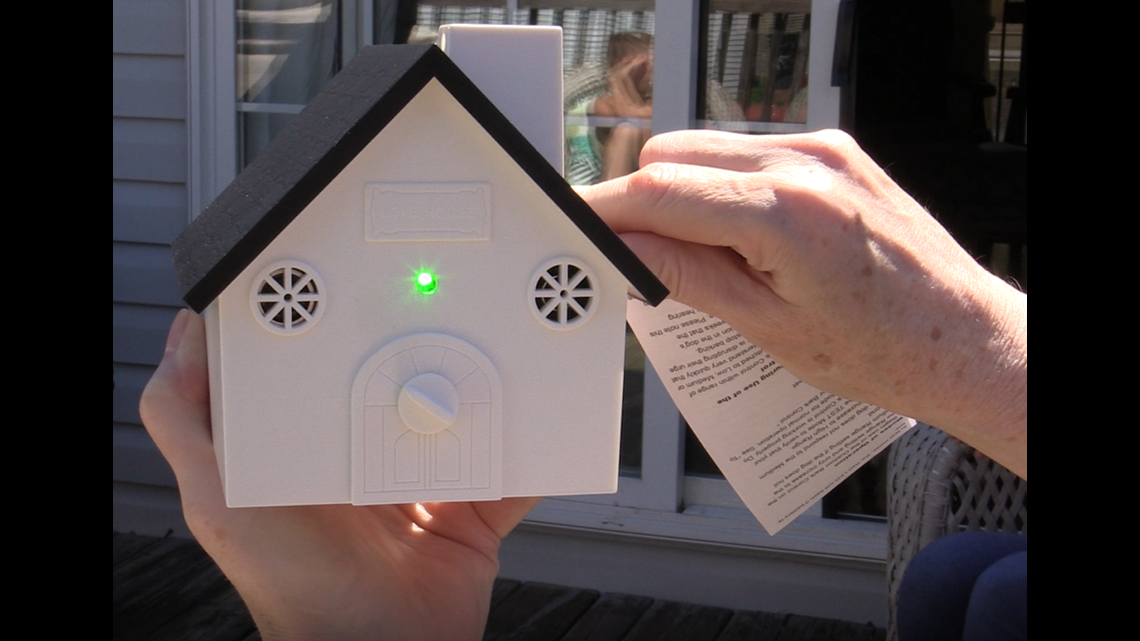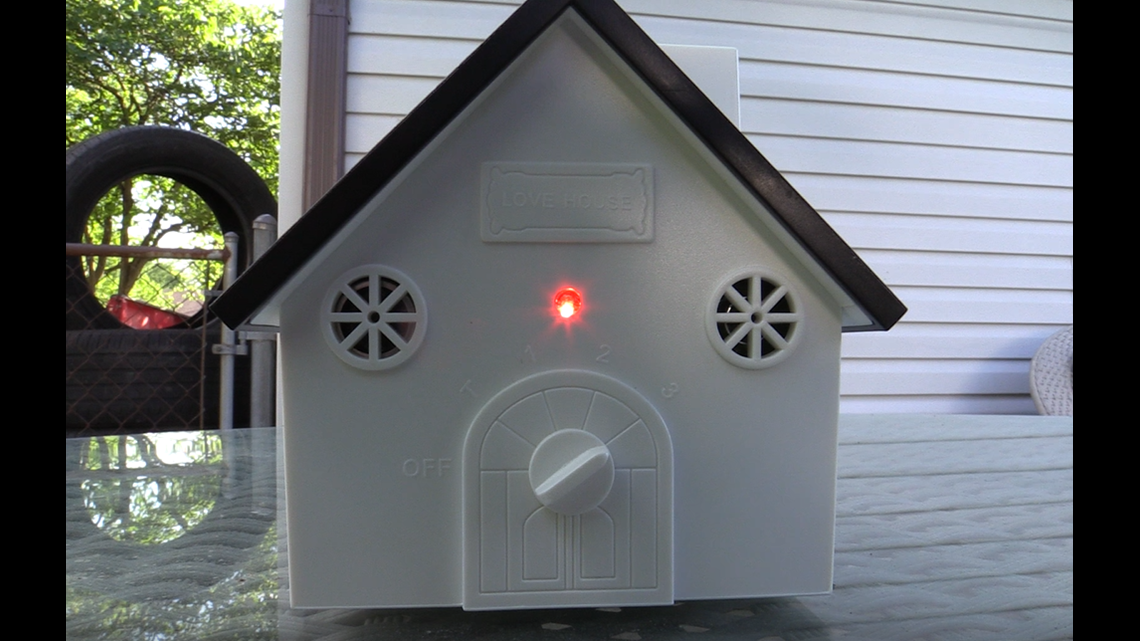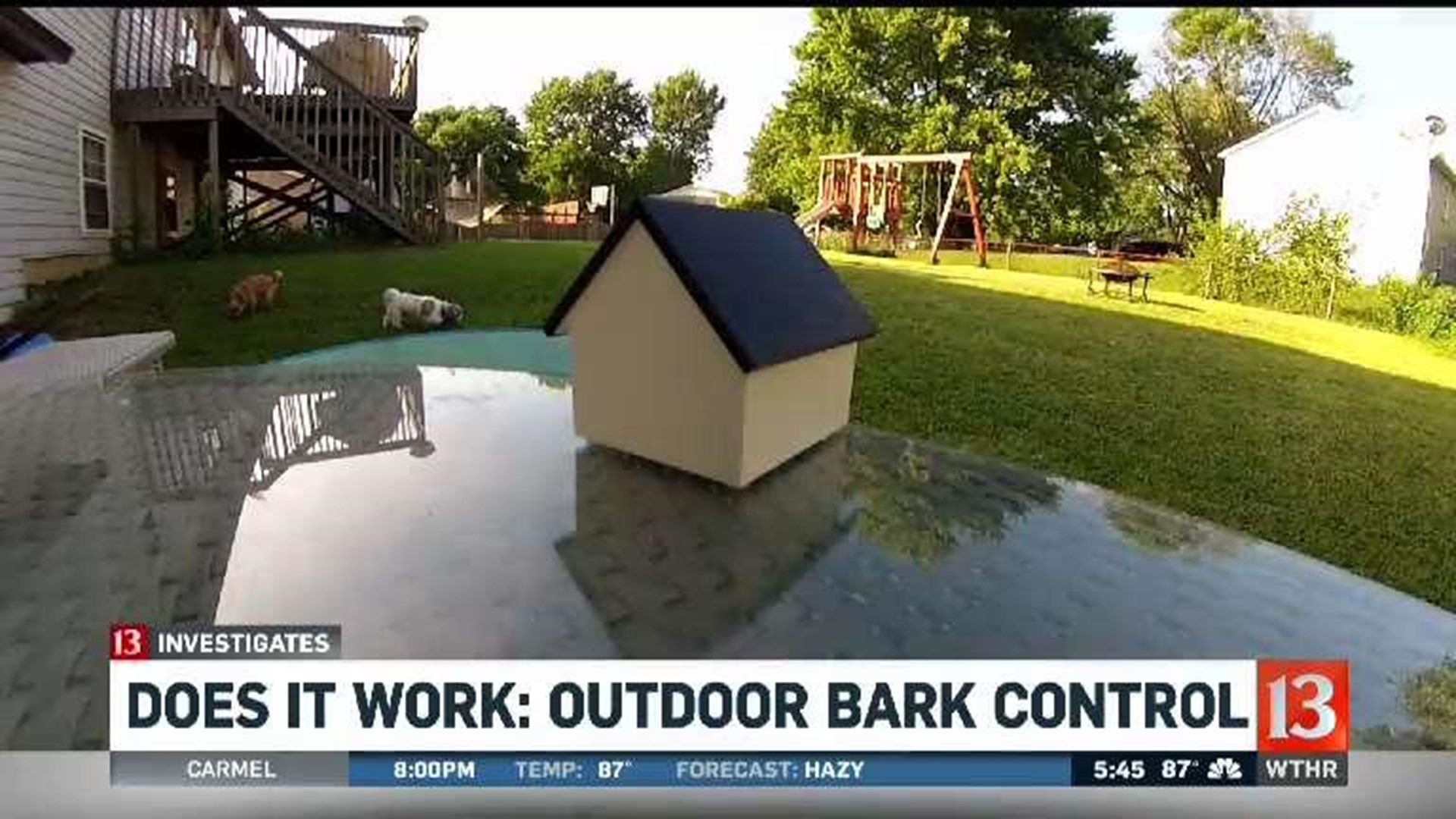INDIANAPOLIS (WTHR) — Diana Calkins adores her two dogs, but she's the first to admit they sometimes drive her crazy.


JuJu (short for Junie B. Jones, the young, spirited girl who serves as the protagonist of a children’s book series) is a spunky Shichon who barks at the first sign of visitors.
Vicki, described by her owner as a “mostly Chihuahua rescue mutt,” barks at the first sign of, well, almost anything. Named in honor of Indiana Pacers all-star guard Victor Oladipo, Vicki is full of energy and in constant motion. “She’s smaller than the other dogs, but she’s fearless and has a 4-foot vertical leap,” explained Calkins.
The dogs are small, but when they are both awake, Calkins’ south side Indianapolis home can get very noisy.
“Anytime anyone comes in, they bark. Anytime the neighbors do anything out of the ordinary, they go crazy,” Calkins explained, shaking her head. “There’s incessant barking the whole time the neighbor mows his lawn. They bark at the neighbors’ dogs. And with these little dogs it's a very, very high pitch. It hurts your ears.”


That's why Calkins has had her eye on Outdoor Bark Control, a product that claims to use ultrasonic sound to stop dogs from barking. The device looks like a small plastic house and has a microphone inside. According to its user’s manual, when the Outdoor Bark Control unit detects the sound of barking, it emits its own high-pitch noise that “can be heard by dogs but is silent to humans.” That unpleasant, startling noise is supposed to annoy your dog and prompt it to stop yapping. When the barking stops, the ultrasonic sound stops, as well.
“Seems like a good idea, and I’ve been curious as to whether or not that works,” Calkins told WTHR, eagerly offering up JuJu and Vicki as product testers. So 13 Investigates purchased the device to see if it delivers on its promise to deter nuisance barking.
Good first impression
Set up was easy. The small, plastic device requires a 9-volt battery (not included) which Calkins installed in less than a minute. She then followed the product’s instructions to test the device’s audio sensors, which showed the Outdoor Bark Control unit was properly detecting the sound of barking.
Calkins then placed the product on her patio table to see what would happen.


The first few days of the test didn’t provide any useful results. Because of very hot temperatures, Vicki and JuJu spent most of their time indoors, out of range of the Outdoor Bark Control unit. Their frequent indoor barking prompted Calkins to move the device inside – something the manufacturer does not recommend. (Neither the user’s manual nor online materials provided details explaining reasons for not using the product inside.) She noticed an immediate impact.
“The minute I turned it on, they stopped barking,” said Calkins.
13 Investigates observed the dogs’ behavior as a visitor knocked on the front door and rang the doorbell, two triggers that normally result in prolonged barking. With the bark control device operating just a few feet away on its lowest setting, JuJu and Vicki both ran toward the front door and each let out a single bark in response to the noise at the door.
“Definitely a difference. They would have been barking liking crazy. It definitely worked,” Calkins said enthusiastically. “Usually there’s nothing that will distract them, and this seems to do it.”
Unexpected turn
But the excitement did not last long.
After the impressive indoor test, JuJu and Vicki went outside to play. Calkins returned the Outdoor Bark Control device to her backyard patio table and increased the unit’s sensitivity to a higher setting.


Within just a few minutes, a neighbor's dogs decided to come outdoors, too. Things got very noisy very quickly, with several minutes of sustained, intense barking by dogs on both sides of the backyard fence. The Outdoor Bark Control says it effectively stops barking up to 50 feet away. Obviously no one bothered to inform JuJu and Vicki.
Face-to-face with their nextdoor neighbors, the dogs did not seem to notice the presence of the anti-barking device. The unit appeared to be sending out ultrasonic noise – we could not hear it but did see a red flashing light indicating that the device was emitting a sound in response to barking – the entire time JuJu and Vicki were yapping.
“I don’t think it worked very well,” Calkins said, clearly disappointed and pausing for nearly 20 seconds while her dogs continued to bark at the canines next door. “As soon as those dogs came out, they were all barking like crazy. Obviously it didn't work on the neighbor's dogs either, and we were within 10 or 15 feet of the box and there seems to be no effect at all.”
Is it safe?
If you browse online or at local pet stores for products that claim to deter barking, you’ll quickly find a number of devices that utilize ultrasonic sound.


Ultrasonic refers to sound frequencies above 20,000 hertz, which is the upper limit of sound that is generally audible to the human ear. Dogs have much more sensitive hearing – up to 45,000 hertz – so anti-barking products use frequencies in that higher-frequency range.
Aside from the effectiveness of such devices, 13 Investigates also inquired about their safety. Local veterinarians consulted by WTHR expressed few concerns about the technology’s impact on dogs.
“It’s not going to be hurtful to dogs, and it’s not going to hurt their eardrums,” said Denise Katz, a veterinarian and director of professional development at Noah’s Animal Hospitals.
“Are they safe? I believe yes, they are, within reason,” agreed Meredith Engerski, the practice manager at Allisonville Animal Hospital and Cottage Animal Clinic in Hamilton County. She recommends these types of devices be used only for short periods of time to train dogs since there are few published studies to show the long-term impact of ultrasonic sound on animals’ hearing.
“There is not a lot in the literature to suggest it leads to hearing loss or neurological problems in dogs … but I’d say there’s a lack of studies,” said Amanda Rigterink, a Lebanon veterinarian who specializes in animal behavior. “I do worry more about it being a nuisance and causing increased anxiety in dogs because they are a lot more sensitive to sounds than we are, so it can be bothersome.”
Not a cure
All of the veterinarians who spoke with WTHR said their customers have not found ultrasonic devices to be particularly effective in stopping unwanted barking.


“Some dogs might be bothered by it and stop barking, and some might be very agitated by the sound and bark more,” Rigterink said.
Katz said she does not recommend ultrasonic devices for homes with more than one dog because it may severely affect one dog where it doesn’t impact the other at all.
“You could also be in a situation where you may be correcting a dog that’s already shut up and doesn’t bark anymore, and if you have another dog that doesn’t care and keeps barking, that can create a hostile relationship between the dogs,” said Katz.
“Every dog is different. I've seen people try to use it and come in and say it hasn't worked because their dog is just fighting through it and they're just barking at whatever source [caused] the barking to begin with,” added Engerski.
Online reviews show mixed results for customers who purchased the same Elenest Outdoor Bark Control unit tested by Calkins. The product currently gets 2.4 (out of 5) stars on Amazon.com. Some reviewers wrote “works great” while others said it’s a “waste of money.” It is available from various online retailers for $30 to $45.
Overall, Calkins gave the product a grade of C-. She said at certain moments, the Outdoor Bark Control seemed very effective. At other times, JuJu and Vicki barked nonstop as if it wasn’t there.
“Still looking for solutions,” she said. “I kind of liked it in the house, but outside I don’t think it worked.”
Veterinarians warn pet owners against the idea that an ultrasonic bark control product will be a “cure” for their dog’s barking problems.
“They might modify behavior, but they don’t address the underlying motivations and reasons for the barking,” explained Rigterink, who runs Veterinary Behavior of Indiana.
“I recommend trying to find the reason this is happening — why is it happening — and then modifying that,” agreed Engerski.
How do you curb your dog’s barking


There is no one-size-fits-all solution for putting a stop to barking. “It really does depend on why they are barking in the first place,” said Mica Riedner, a professional dog trainer at Paws & Play Training Center in Fishers.
Here are Riedner’s tips for pet owners looking for relief from constant barking:
- Don’t yell at your dog. While your dog is barking, avoid the urge to constantly tell your dog "stop" or "quit," and don’t raise your voice. “To your dog, it sounds like you’re barking back, and you’re not going to get anywhere,” Riedner said.
- Figure out the “Why?” Like a baby that is crying, a dog usually barks to express a need or emotion. Figure out what that is, address the need, and you’re on your way to stopping the noise. (Does your dog bark because she’s scared by the sound of fireworks? Keep her indoors, give her some loving reassurance and play soothing music. Is your dog barking because a would-be intruder is lurking in your backyard? You may not want her to stop barking.)
- Remove triggers. This is not a long-term solution, but if you know your dog goes nuts when he sees a squirrel on your deck, shut the curtains or close the blinds. “Sometimes your quickest and easiest route is just putting a Band-aid on the situation and remove them from what’s motivating them to bark,” Riedner said. “If you really need the barking to stop, there’s nothing wrong with a momentary fix.”
- Desensitize your dog. Once you figure out what is causing your dog to bark, turn that trigger into something positive. Riedner said her dogs used to bark incessantly each week at the sight and sound of the garbage truck. Here’s how she changed that: “When the trash truck would pull onto the street, I’d call to them, give them treats, tell them they were good, and continue to do that until the truck passed. Now there’s no reaction at all. It’s desensitization. They now associate the trash truck coming with getting treats, and so it’s not so scary anymore.”
- Teach the command “Quiet.” This one is tricky because for your dog to understand the term "quiet," she first needs to understand the command “speak.” Yes, that’s right, you basically have to teach your already yappy dog to bark before you can teach her to hush up. Riedner said it’s not as difficult as it sounds, especially if you have a dog that’s a barker. “If you’re dealing with a dog that already has a barking problem, start saying 'speak’ to them while they’re barking. They’re probably going to stop and look at you, they’ll give a few more barks, and then tell them ‘good!’ and give them a treat. Just keep doing that and eventually they’re going to be like ‘OK, when I hear that word, she actually wants me to bark,’ and that’s what you’ll get,” the trainer explained. “Once they do that consistently, when they stop barking, say ‘quiet,’ then give them a treat and repeat that process until they understand the command. Be consistent. Consistency is key.”
- Wait it out. If you’re the patient type, you can always wait for the barking to stop, and then reward the silence. “They’re going to have to stop to take a breath at some point,” said Riedner. “When they do, just pop a treat in their mouth, and tell them they’re good.”
- Keep your dog mentally exhausted. “Often times, dogs that have a barking problem are bored. They don’t have enough going on in their life,” Riedner said. To remedy that, she recommends not only keeping your dog physically active with walks, but also keeping them mentally active with challenging, interactive toys. She trains dogs to use balance balls and a treadmill (seriously). “Keep them busy and engage their mind … a dog whose mind is tired is going to be very well behaved,” she said.
If there is a product you'd like 13 Investigates to test, let us know. Send information about the product to 13investigates@wthr.com. We’ll let you know if your suggestion will be featured in an upcoming 13 Investigates product test report.

